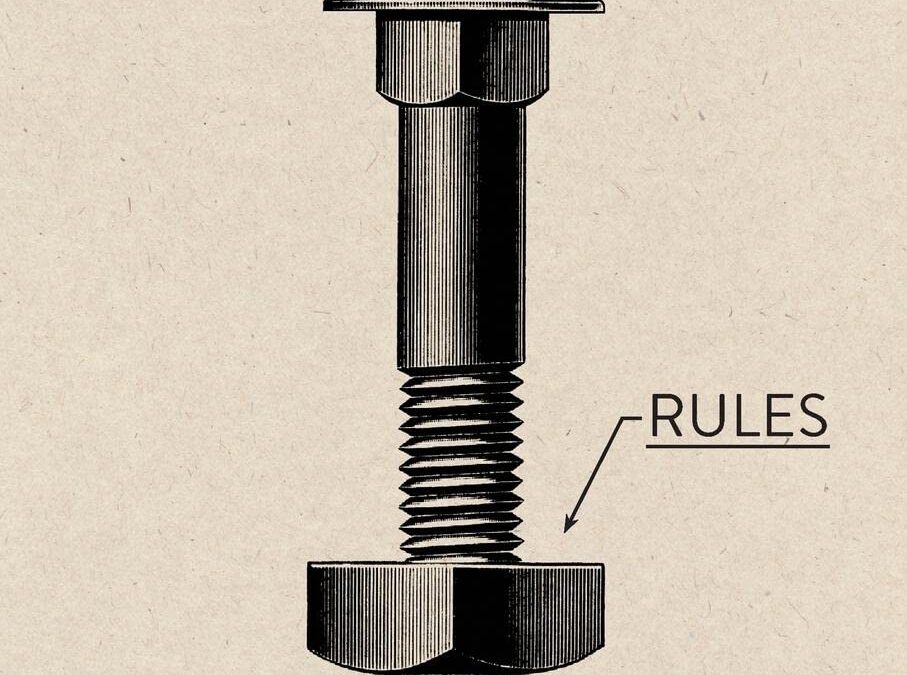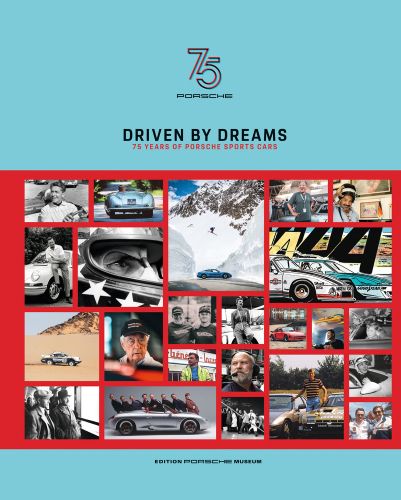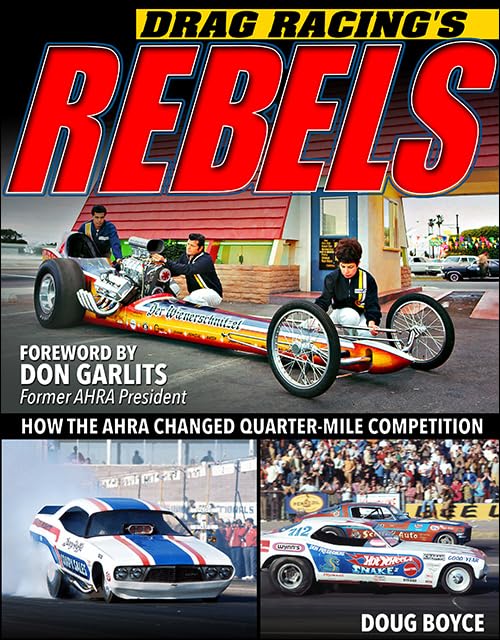
Learn the entire fascinating story of the American Hot Rod Association (AHRA) in this wonderfully illustrated color history.
When the National Hot Rod Association (NHRA) was formed in 1951 by Wally Parks, the reasoning for the formation was to “create order from chaos” by instituting safety rules and performance standards that helped legitimize the sport of drag racing. Some organization was certainly necessary. A postwar boom in automotive enthusiasm was reaching new heights, and Hot Rod magazine and the NHRA were right in the thick of it.
The NHRA hosted its first drag racing event in 1953, and in 1955, the organization staged its first national event, which was simply called “The Nationals.” The AHRA formed in 1956 as an alternative to the NHRA, where the drivers voted on the rules (rather than sanctioning bodies and tracks), and their influence on the sport was felt almost immediately.
When the NHRA denied the use of nitromethane in 1957, the AHRA approved it. When the NHRA banned aircraft-powered dragsters in 1961, the AHRA welcomed them. When the NHRA said no to the emerging Funny Car in 1965, the AHRA said yes. When fans and racers screamed for a heads-up Super Stock category in 1968, the AHRA delivered. The AHRA was called a rebel association. Some say that it was more of an association that got things done–to the delight of fans and racers. The AHRA was on equal ground with the NHRA by the 1970s, drawing enormous crowds and racer entries.
In this fascinating history, veteran author Doug Boyce tells the story of the AHRA: the rise, the competition, the events, and the eventual downfall of the organization. After AHRA President Jim Tice passed away in 1982, internal fighting for control of the association resulted in its doom. Get the whole story here, and add this wonderful volume to your drag racing library.
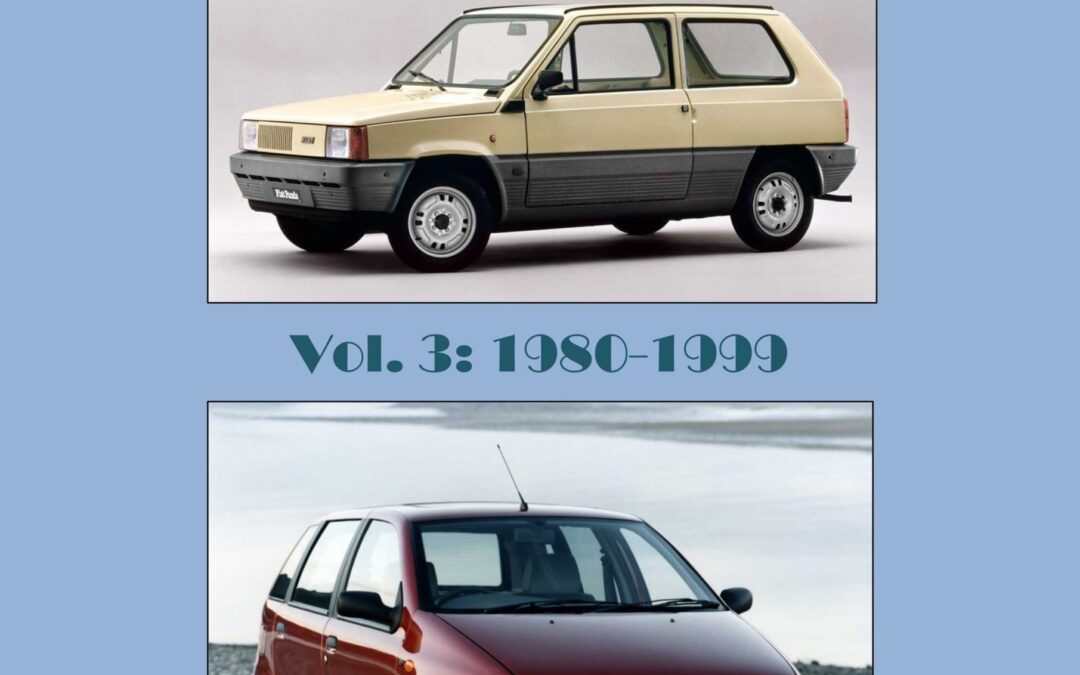
Fiat – Twenty More Years Volume 3 is the final volume on 100 years of Fiat automobiles. A4 format, soft colour covers, 125 pages with 3-4 images per page. Includes Image Credits, References, Bibliography and an Index covering all three volumes, 1899-1999.
This volume covers a period when rapid changes were taking place throughout Europe, including the collapse in 1989 of the USSR’s control of its eastern European empire, the Iron Curtain states of Poland, Hungary, Romania, Czechoslovakia, Bulgaria and the DDR – East Germany. This was almost immediately followed by the collapse of the USSR itself.
New cars were being launched by Fiat, including the iconic Panda, the Uno, Tipo, Regata, Punto, Barchetta, Coupe, Cinquecento and Seicento, Bravo and Brava, Ulysse, Palio and finally the ‘ugly duckling’ Multipla. All Fiats were now front-wheel drive, the old 131 and Argenta rear-wheel drive cars were consigned to history.
Many changes took place within Fiat itself, with Gianni Agnelli searching for a family member able to take over from him when he retired. Several family members were groomed because Gianni’s only son, Edoardo, proved to be a dilettante and incompetent. Agnelli and his Rottweiler, Cesare Romiti, faced down the powerful Italian unions in a battle for control of the company in the face of strikes and social unrest, with Fiat unable to make the numbers of cars they wanted and the quality of those cars suffering as a result of inattention by workers on assembly-line. Automation was progressed as a result, eliminating many jobs. Nevertheless, this twenty-year period produced many sought-after Fiat models which are now regarded as classics.

Volume 2 of the Encyclopedia 727 about one of the most famous and important airplanes in history, and Boeing’s first bestseller, best-selling commercial jet for more than two decades. The Boeing 727 is an aviation icon! Its grandiose story is told in detail in Encyclopedia 727. For the first time in history, an entire encyclopedia dedicated to a single plane!
The 6 volumes will tell the complete story in 2,640 pages, with more than 3,200 photoreal profiles and exclusive to the 727 Encyclopedia, showing the plane in every painting in the airlines that have operated it in the more than 59 years of use of the model until today. All books have digital content with access via QR code and the sections will receive updates on the data of the aircraft in operation, which can be downloaded in PDF and printed, keeping your 727 Encyclopedia up to date.
In volume 2 you will learn about the different models of the 727, with details of each variant of the factory Boeing 727 and the modifications received to extend its operational life, testimonials from pilots and other professionals about the trijet, the most unusual stories that happened with the model , an account of all the accidents involving the device and more: the 727 in the media, flight simulators, statistics, preserved planes, in addition to the production list and a complete chronology of the model’s history. Finally, a section dedicated to plastic models and collectors, with the 727 at scale.
Volume 2 has 376 pages.
Sections of Volume 2: 1. MODELS & DESIGNS, 2. THE 727 AND ITS FRIENDS, 3. FANTASTIC STORIES, 4. ACCIDENTS, 5. THE 727 IN THE MEDIA, 6. THE 727 AT SCALE, 7. THE 727 IN THE SIMULATORS, 8 The 727 IN STATISTICS, 9. THE 727 PRESERVED, 10. PRODUCTION LIST, 11. CHRONOLOGY.
Details: more than 100 photos (some exclusively colorized for the book), more than 259 photoreal profiles of 727’s, 370 artwork, maps, infographics, 71 tables and 149 QR codes with external content, including videos, documents and miscellaneous content about the trijet.

This is the Volume 1 of the Encyclopedia 727, that will cover the full story of the Boeing 727, one of the most important jetliners of all time. Volume 1 has 360 pages that covers the backstage of Boeing’s risky bet to develop the 727 (Chapter 1), an explanation of the advanced technical features of the trijet (Chapter 2), the successful marketing strategy to market the airplane (Chapter 3), the 727 and its main operators in the world (Chapter 4) and its operation in Brazil (Chapter 5). It has more than 150 pictures, almost 500 photorealistic and exclusive profiles, along with 12 maps, 35 infographics and many more.

Over the course of performance car history, and specifically muscle car history, big-block engines are particularly beloved, and for good reason. Not only are they the essence of what a muscle car is, but before modern technology and stroker engines, they were also the best way to make a lot of horsepower. All of the Detroit manufacturers had their versions of big-block engines, and Ford was no exception. Actually, Ford was somewhat unique in that it had two very different big-block engine designs during the muscle car era.
The FE engine was a design pioneered in the late 1950s, primarily as a more powerful replacement for the dated Y-block design because cars were becoming bigger and heavier, and therefore, necessitated more power to move. What started as torquey engines meant to move heavyweight sedans morphed into screaming high-performance mills that won Le Mans and drag racing championships through the 1960s. By the late 1960s, the design was dated, so Ford replaced the FE design with the “385” series, also known as the “Lima” design, which was more similar to the canted-valve Cleveland design being pioneered at the same time. It didn’t share the 1960s pedigree of racing success, but the new design was better in almost every way; it exists via Ford motorsports offerings to this day.
In Ford Big-Block Parts Interchange, Ford expert and historian George Reid covers these engines completely. Interchange and availability for all engine components are covered including cranks, rods, pistons, camshafts, engine blocks, intake and exhaust manifolds, carburetors, distributors, and more. Expanding from the previous edition of High-Performance Ford Parts Interchange that covered both small- and big-block engines in one volume, this book cuts out the small-block information and devotes every page to the MEL, FE and 385 series big-blocks from Ford, which allows for more complete and extensive coverage.
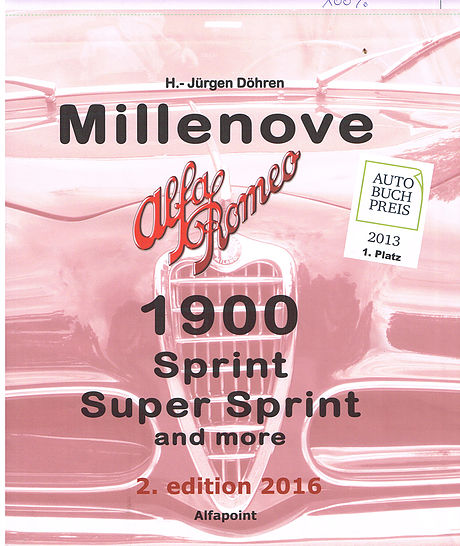
The Alfa Romeo 1900 story, a great beginning after the Second World War.
Alfa Romeo anticipated the worldwide developing need for a fast sports sedan with luxurious comfort, excellent handling and top performance in the early 1950s.
The 1900 embodies the successful synthesis of these values for the first time and thus highlights the difference between production and “Coachbuilt” vehicles. Its centerpiece is the engine designed by Orazio Satta with two overhead camshafts, a design that revolutionized modern engine construction. In the TI version, this engine delivers 100 hp and was victorious in many international races.
Not only the factory, but also the bodybuilders of the era made their decisive contribution to making something special out of the 1900 project.
Within a few years the designers and car body manufacturers developed an amazing variety of 1900 based cars. By the end of the era, there were 17 different, mostly small producers, who built their own cars on the Alfa Romeo 1900 platform.
All these vehicles, about 70 in number, will be presented in this book for the first time in a complete and detailed way.
The second edition of this successful work has been completely reworked, many photos have been exchanged and the layout has also been improved. The hard cover book covers 320 pages with more than 700 color illustrations.

The venerable Chevy big-block engines have proven themselves for more than half a century as the power plant of choice for incredible performance on the street and strip. They were innovators and dominators of the muscle car wars of the 1960s and featured a versatile design architecture that made them perfect for both cars and trucks alike. Throughout their impressive production run, the Chevy big-block engines underwent many generations of updates and improvements. Understanding which parts are compatible and work best for your specific project is fundamental to a successful and satisfying Chevy big-block engine build.
In Chevy Big-Block Engine Parts Interchange, hundreds of factory part numbers, RPOs, and detailed color photos covering all generations of the Chevy big-block engine are included. Every component is detailed, from crankshafts and rods to cylinder heads and intakes. You’ll learn what works, what doesn’t, and how to swap components among different engine displacements and generations. This handy and informative reference manual helps you to create entirely unique Chevy big-block engines with strokes, bores, and power outputs never seen in factory configurations. Also included is real-world expert guidance on aftermarket performance parts and even turnkey crate motors. It s a comprehensive guide for your period-correct restoration or performance build.
John Baechtel brings his accumulated knowledge and experience of more than 34 years of high-performance engine and vehicle testing to this book. He details Chevy big-block engines and their various components like never before with definitive answers to tough interchange questions and clear instructions for tracking down rare parts. You will constantly reference Chevy Big-Block Parts Interchange on excursions to scrap yards and swap meets, and certainly while building your own Chevy big-block engine.
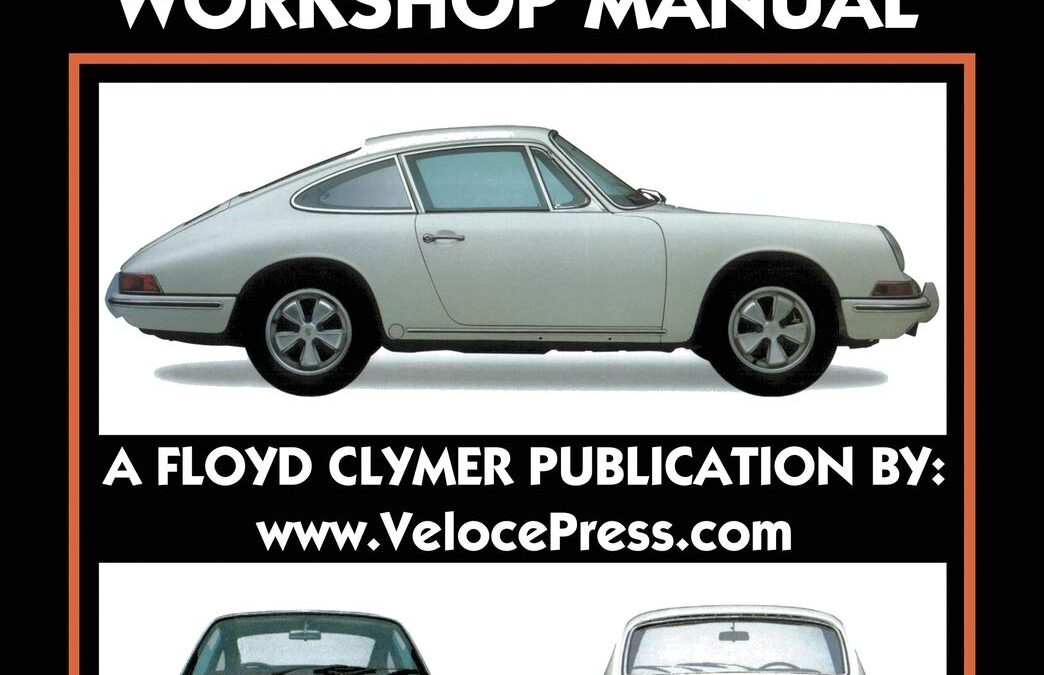
Revised and updated to a larger format than the original, this Floyd Clymer publication includes complete technical data, service and maintenance information and comprehensive detailed instructions for the repair and overhaul of all major and minor mechanical and electrical components for the 1964 to 1973 Porsche 911 series of automobiles including the 2.0 Litre (1964-69), the 2.2 Litre (1969-71) and the 2.4 Litre (1971-73).
This manual is broken down into the following sections: Engine, Carburetters & Fuel System (including Fuel Injection), Ignition System (including Capacitive Discharge CDS system), Cooling, Heating & Exhaust Emission Systems, Clutch, Manual Transmission & Sportomatic Transmission, Rear Suspension & Drive Axles, Front Suspension, Steering, Brakes, Electrical System (including Wiring Diagrams) and Body (including Paint Codes & Door Hardware parts interchange). There is also a chapter that includes Torque Settings, comprehensive Technical Specifications and Lubrication information.
Profusely illustrated with more than 300 illustrations and charts, there is adequate detailed text and diagrams to assist in major refurbishing such as an engine rebuild or even a complete mechanical renovation making it an invaluable resource for collectors and restorers of these iconic automobiles.
206 pages, 300 plus illustrations, size 8.25 x 10.75 inches.
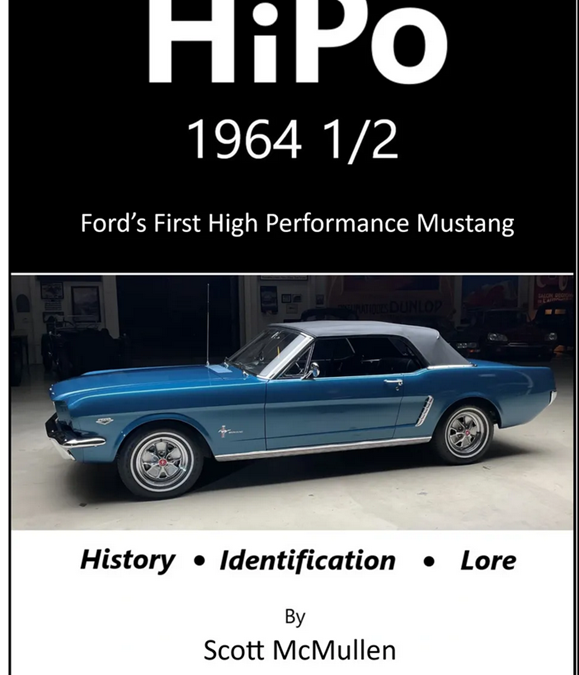
Introducing “HiPo 1964 1/2 Ford’s First High Performance Mustang – History, Identification, Lore”. Dive into the thrilling world of Ford’s iconic 64 1/2 K code Mustang with captivating stories and stunning visuals. A must-have for every auto enthusiast!
The authoritative guide to Ford’s original street legal race-bred Mustang and one of the world’s rarest collector cars, whose fascinating story is sure to entertain a wide range of automotive enthusiasts – not just Mustang fans – covering history, early prototypes, development/testing, production, characteristics/parts, restoration/preservation, and much more. (Hardcover, 347 pages, 157 photos/images both color and black & white.) By Scott McMullen with foreword by Jay Leno.
“HiPo 1964 ½ Ford’s First High Performance Mustang” focuses on one of Ford’s rarest production cars – rarer than the 1965-1966 Shelby GT 350 and the only option for Mustang performance buffs prior to August 1964. Also known as HiPos or K codes, most enthusiasts are aware of the 65-66 models, but little about the 64 ½ HiPo Mustangs, has been available. The 64 ½ cars were the original embodiment of the street legal race-bred Mustang. Their fascinating story is sure to entertain a wide range of automotive enthusiasts – not just Mustang fans.
The book includes rare, and in some cases, never-before-published pictures of early High Performance Mustang prototypes and pre K code mustangs production cars. Included are details of experimentation and production along with in-depth discussions of how research and development progressed through the start of 64 ½ K code production up to the start of 65 production. Also explored is the lore of these classic muscle cars and the test drivers, like Dan Gurney, who helped wring them out.
This information is invaluable to the collector and automotive performance enthusiast alike. Even the most knowledgeable Mustang aficionado will find new information, some of which will challenge old notions and lore that has been told through generations of Mustang fans the world over. The book goes on to present tips for preserving and restoring a 64 ½ HiPo Mustang. It further delves into characteristics of an authentic 64 ½ K code Mustang along with how they changed through the few weeks in 1964 that these ultra rare cars were produced.
Hardcover, 347 pages, 157 photos/images both color and black&white.

This book is unique. It not only tells you how carburetors work – but more importantly – why.
Carburetors, like many parts of a car, are not stand-alone devices. A carburetor’s “success” is highly dependent on many related components working together, just like the members of a football team must work together in order to win. We will discuss all aspects of the fuel and air systems of a gasoline engine from the gas tank until the air-fuel mixture enters the combustion chamber. To be able to effectively understand, diagnose and repair carburetors, it is important to understand all of these inter-related systems.
This book will complement the various service manuals you have for your cars. Some books have very good, detailed carburetor descriptions, while others are limited in the discussion of how the particular carburetor works. This book is not intended to replace these manuals, but to give you fundamental knowledge that will apply to virtually all carburetor designs. This book also includes more than just carburetor information, since it is the complete fuel, air, ignition and intake manifold systems that are important to fully understand your vehicle.
Over the past several years, I have been studying the Marvel carburetor calibrations on early Buicks and reporting the results in my “Early Buick and McLaughlin-Buick Owners” newsletter. The variation in air–fuel ratio (A/F) I observed on my 1916 and 1929 Buicks led me to do a more detailed analysis of intake manifold designs, which are critical to achieving an optimum carburetor calibration. It is interesting to see how both intake manifold designs and fuel delivery techniques evolved over the last 100 years.
In addition to my own antique cars, I have been involved in some interesting restorations of historically significant General Motor vehicles. I restored three carburetors used on the restoration of the GM Futurliner #10 and rebuilt the four side-draft carburetors used on the 1956X Buick concept car both restored by my good friend Don Mayton in Michigan. While both vehicles used standard production carburetors, the unique applications made them an interesting and rewarding experience.
The book discusses all aspects of the engine’s demand for air and fuel, how it is achieved and how engine designs affect carburetion. We will trace the carburetor’s evolution from the simple carburetors in the early 1900s, through the more complicated carburetors in the mid-1980s. We will see how emission regulations changed carburetors in the 1970s and 1980s, and ultimately led to electronically controlled fuel injection today. I will also use many analogies to help you understand the concepts in carburetors and fuel systems.
Enjoy and learn.
Dean G. Tryon
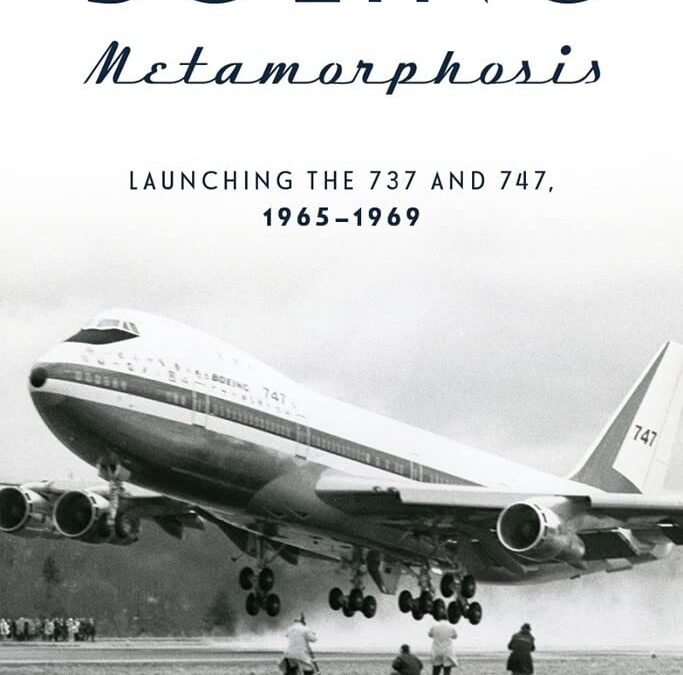
A unique insider look at the profound changes Boeing experienced in the 1960s as the product mix shifted from military hardware to the first generation of jet-powered airliners.
Welcome to the world of corporate decision-making, workplace gambles, and a myriad of human interactions. This is a story that affirms the traditional values of hard work, fidelity, and building the human alliances necessary for achieving enduring success. John Andrew, a retired Boeing executive, offers a unique insider perspective of the changes Boeing experienced in the 1960s.
- The requirement for more factory space was fueled by new models and a surging worldwide demand for air travel.
- Massive construction projects were launched, including a newly constructed 747-sized factory on 760 acres at Paine Field in Everett, Washington.
- These cathedrals of airframe assembly remain vital to Boeing’s ongoing operations today.
- More than 130 color and black-and-white images.
Explore the amazing growth and evolution of Boeing, one of the giants of aviation.

Experience the legendary history of Formula 1 in this new edition of the definitive illustrated book.
Fully revised and updated, Formula 1: The Official History is an electrifying account of the F1 phenomenon, telling the complete story of one of the world’s most popular, thrilling, and glamorous sports. Bringing together a superbly written account of the history of the sport by acclaimed author Maurice Hamilton, and an exceptional selection of stunning images from across seven decades of F1 racing, the book charts the FIA Formula One World Championship, decade by decade, from its first race at Silverstone in May 1950 right through to end of last season’s championship.
Each chapter tells the fascinating stories behind the greatest drivers and teams, important personnel, famous and infamous incidents, as well as key changes to the rules on design, safety and competitiveness. These tales are accompanied by more than 250 exceptional photographs featuring icons past and present, including Ayrton Senna, Michael Schumacher, Alain Prost, Sebastian Vettel, Lewis Hamilton and Max Verstappen. Accessible and entertaining for any F1 fan, and with a foreword by Ross Brawn, Managing Director of the FIA Formula One World Championship, this is the definitive visual history of the sport.

Bunker Hill is the highest point of downtown Los Angeles, both literally and figuratively. Its circle of life has created a continuous saga of change, each chapter rich with captivating characters, structures, and culture. In Bunker Hill Los Angeles: Essence of Sunshine and Noir, historian Nathan Marsak tells the story of the Hill, from the district’s inception in the mid-19th century to its present day. Once home to wealthy Angelenos living in LA’s “first suburb,” then the epicenter of the city’s shifting demographics and the shadow and vice of an urban underbelly, Bunker Hill survived its attempted erasure and burgeoned as a hub of arts, politics, business, and tourism.
As compelling as the story of the destruction of Bunker Hill is―with all the good intentions and bad results endemic to city politics―it was its people who made the Hill at once desirable and undesirable. Marsak commemorates the poets and writers, artists and activists, little guys and big guys, and of course, the many architects who built and rebuilt the community on the Hill―time after historic time.
Any fan of American architecture will treasure Marsak’s analysis of buildings that have crowned the Hill: the exuberance of Victorian shingle and spindlework, from Mission to Modern, from Queen Anne to Frank Gehry, Bunker Hill has been home to it all, the ever-changing built environment.
With more than 250 photographs―many in color―as well as maps and vintage ephemera to tell his dramatic visual story, Marsak lures us into Bunker Hill Los Angeles and shares its lost world, then guides us to its new one.
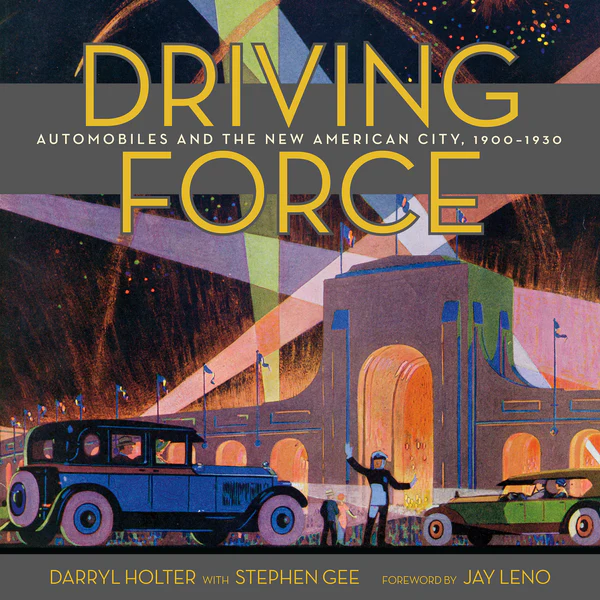
Driving Force: Automobiles and the New American City 1900-1930 (Angel City Press) explores how Los
Angeles’s enigmatic car culture propelled the explosive growth of America’s passion for cars. And with thoroughly researched text and page-after-page of vintage images, it shows how roadblocks that limited the sales of automobiles in the rest of the country, were eliminated in a new-thinking city in the earliest days of the car industry.
At the dawn of the twentieth century, as Los Angeles transformed from a rugged outpost to a booming metropolis, so too did the fledgling automobile simultaneously come of age. Ignited by an unlikely and visionary mix of entrepreneurs who ventured into unknown territory, early adopters broadened the market and convinced the public that cars were no longer a luxury—they were the ultimate modern necessity. From these early enthusiasts, men and women in various business recognized that the automobile would change society and wanted a piece of that action. The city’s auto business emerged initially among bicycle shop owners, carriage retailers, and automobile aficionados who started selling—and repairing!—cars. Their workshops thrived, expanded, and eventually became dealerships, the key component to the auto boom.
In this first major history of dealers at work—and one of the first books to chronicle the early history of cars in Los Angeles—authors Darryl Holter and Stephen Gee share the untold story of pioneering automobile dealers who seized the chance to join a start-up industry that reinvented an American city. Some became wealthy and powerful, others failed. But the lure of the automobile never wavered.
The L.A. dealers helped change the way cars were sold. They championed selling cars on credit while accepting“used cars” that buyers “traded in” so they could buy a new one. They introduced the West Coast to the concept of dealerships with service bays for on-site car repairs; persuaded manufacturers to design cars to their specifications and created custom vehicles and innovations that were copied around the country.
With more than 150 spectacular vintage images—many never before published—Driving Force brings to life the people who made the automobile an icon of the modern American city. In its pages, readers will discover how the story of the automobile is interwoven with Southern California’s unique topography and sun-drenched climate; a new era of women’s rights, and a growing female influence on automobile design; the creation of the Los Angeles Auto Show and the remarkable 1929 fire that threatened to destroy it; and how car dealers launched renowned L.A. radio and television stations, including KNX, KFI, and KCBS-KCAL.
As car collector extraordinaire Jay Leno explains in his Foreword to Driving Force, “Darryl Holter shows that auto retailers connected manufacturers to buyers, changing America and shaping the history, economy, and culture of Los Angeles.”

Formula One 2023, the world’s bestselling Grand Prix handbook, is the essential resource for the season ahead.
Formula 1 fans will be kept fully up to speed with detailed examinations of all the teams racing in 2023 (from Ferrari and Red Bull to Mercedes and Aston Martin), every driver in the competition (including Charles Leclerc, Max Verstappen and Lewis Hamilton), and all the tracks featured on the packed Grand Prix calendar, including the new Miami street circuit. It also reviews the 2022 season with race-by-race reports and statistics; highlights changes to the rules and regulations for 2023, and discusses major talking points in F1. As well as the drivers’ and constructors’ world championship tables from 2022, there is a fill-in guide for 2023, so each book can become a personalised record of the Formula One season.
Complementing Bruce Jones’s insightful text are dozens of colour photographs, detailed circuit maps and a statistics section containing the major records from more than 70 years of the world’s most thrilling and glamorous motor sport.
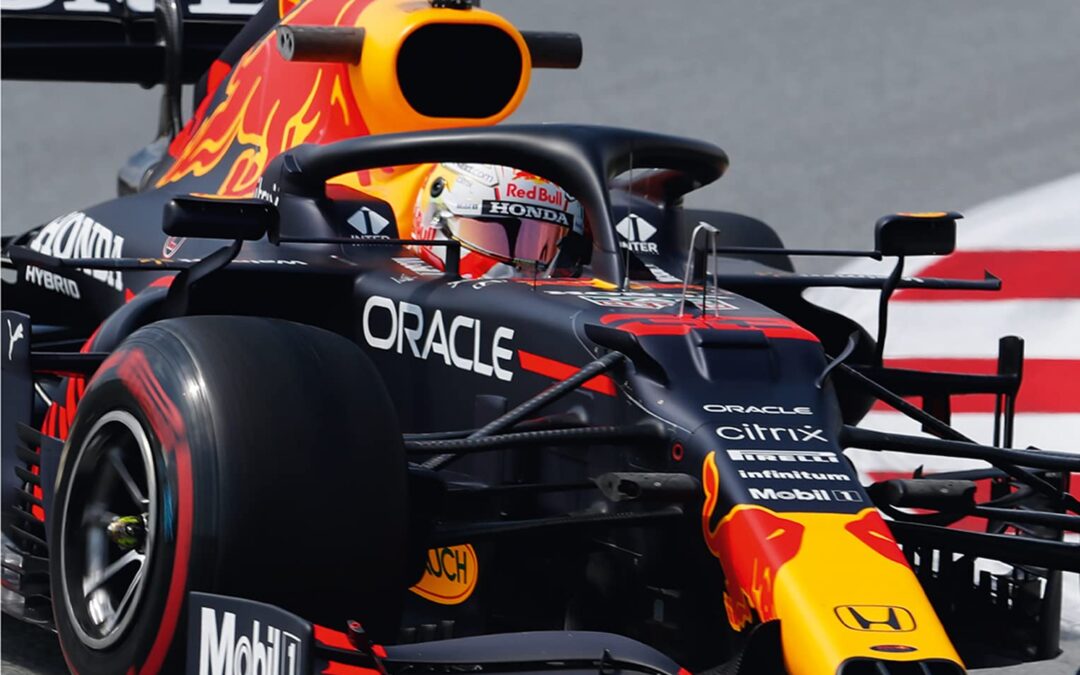
71st YEAR – First published in 1951 – The longest running motor racing yearbook. Independent and authoritative editorial combined with the sport’s finest photography Despite the pandemic, AUTOCOURSE celebrated its 70th year of publication in 2020, a year turned on its head by Covid-19. Thanks to the FIA and racing’s management, F1 was rescued, with a compelling 17-race championship spanning Europe and the Middle East. For 2021 a record 22-race schedule was planned, and despite changes to venues, the F1 championship was very much up and running by March 2021. Mercedes and Lewis Hamilton – now the winningest driver in history – broke more records. The Briton smashed through the 100 pole-position barrier, and moved inexorably toward a century of Grand Prix wins in the face of a real championship challenge from Max Verstappen. Red Bull Racing and Honda seemed to have all but matched Mercedes to provide the fans with a thrilling wheel-to-wheel battle, which would end up with some controversial collisions as the season reached boiling point. Authors Tony Dodgins and Maurice Hamilton, combining almost 80 years of F1 expertise, examine each round in depth. Full race reports are backed by detailed results, including lap charts and tyre strategies. The nuances of F1’s designs and development are analysed team by team by the much-respected Mark Hughes, enhanced by Adrian Dean’s handsome F1 car illustrations. Motor racing’s other major categories are also fully covered: Toyota’s WEC and Le Mans sports car successes; the closely-fought F2 and Formula 3 championships, featuring emerging young talent from around all continents the world; and Nick de Vries emerging victorious in the tight fought Formula E series for electric powered single seaters. AUTOCOURSE includes all the hectic action from the top Touring Car series – the World Touring Car Cup and the British Touring Car Championships as well as the reconfigured DTM Series now running GT cars from Audi, Mercedes, BMW and Ferrari. From America, Gordon Kirby recounts a thrilling Indycar series, featuring a mix of youthful talent such as Alex Palou and Pato O’Ward, both of who were vying to overturn the established veterans who have dominated proceedings over the past decade. In an emotional return, Helio Castroneves took record equalling fourth Indy 500 victory, whilst an appreciation is made to paid to the legendary three-time Indy 500 winner the late Bobby Unser. The ever-popular NASCAR stock car series ran from February to November with barely a weekend’s break, to feature more than forty races before the final championship play-off round at Phoenix, Arizona. In a single essential volume, AUTOCOURSE provides the most comprehensive record of world motor sport, complete with full results not found anywhere in a single volume. It is required reading for all motor sport fans worldwide

Learn how to maximize your profits and savings when buying and selling collector cars!
The dealership model is an American institution, and auction houses can trace their roots back to the days of dusty cattle sales. Both have remained unchanged. Since the early 2000s, the internet has shaken up these legacy methods of finding, buying, and selling vintage cars, as a global online marketplace that is open to anyone.
CarTech, in conjunction with Patrick Krook of REV! Muscle Cars, introduces a proven process drawn from 20 years of experience building some of the world’s most significant classic car collections. Whether you are a first-time buyer or an established collector, this book shows you how to locate and buy your dream collector car stress free. Get the car you are expecting every time, creating positive cash flow and keeping the hobby fun for years to come.
Inside this book is an easy-to-follow, heavily illustrated step-by-step method to find, evaluate, negotiate, close, fund, and take delivery of a collector car safely over the internet without leaving your living room. It also includes how to avoid costly purchase mistakes, such as overpaying, fakes, or buying someone else’s headache. Better yet, it delves into details about how to always sell out of advantage, minimizing the overall amount you invest as you build your collection over time. Lastly, it provides all the tools you need for buying and selling when you have that person-to-person driveway transaction.
Why spend tens of thousands of dollars on dealership retail markup, auction fees, and failed purchases when you can obtain your dream car, keep more money in your pocket, and spend more quality time enjoying the hobby? How to Buy and Sell Collector Cars takes you from being a novice to a seasoned buyer/seller while you enjoy the adventure of car collecting.

Learn about the entire history of America’s best-selling vehicle: The Ford F-Series truck.
When Henry Ford first started manufacturing Model Ts more than 100 years ago, he didn’t really have any sort of pickup or truck configuration in mind. However, enterprising people and businesses were modifying those early chassis for commercial use, and it didn’t take long for Ford to figure out that there was a demand for a truck application of the Model T. Soon, Ford was making its own configurations for commercial use, first through third-party body companies and eventually by Ford itself with the Model TT. From these humble beginnings, Ford stumbled onto the basis for one of the most popular vehicles ever built: the Ford F-Series pickup truck.
In Ford F-Series Trucks: 1948–Present, authors Jimmy Dinsmore and James Halderman thoroughly dissect the history of Ford F-Series pickup trucks as seen from a technical viewpoint. Fully covered are all the options, chassis specifications, running changes, and the evolution of these trucks, as they transformed from postwar utilitarian vehicles to the best-selling luxury family cruisers seen today. Not only are Ford trucks the best-selling trucks, they are the best-selling vehicle of any category, cars included.
This book will thrill truck aficionados and Ford historians alike, as it covers the first F-Series models (1948–1952), the ever-popular second-generation F-Series models (1953–1956), the popular Bumpsides (1967–1972), and all the way through the remarkable technology of what is now the 14th generation of the F-Series.
